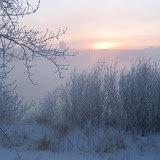
We had originally planned to go to Skaha, a climbing area near Penticton, but at the last minute the weather forecast changed our minds and we decided to go to the Needles in the Black Hills of South Dakota. Apart from the weather it was a long weekend in Canada, so Skaha would likely be busy, but it wasn't a long weekend in the States.
It's about 1100 km which took us about 12 hours. We left early Wed., but didn't go quite all the way the first day, stopping at Hidden Valley campground just past Deadwood. The campground was open, but we never did find any staff. We ended up slipping our fee under the office door. It was a nice spot. We even had some deer wander by our tent.

The tent, however, was not pretty. When I packed I grabbed the three man tent but the two man poles. Needless to say, that doesn't work too well. That's one of the problems with having collected so much gear!
The next morning we drove the rest of the way to Custer, went for breakfast at the Songbird Cafe, picked up some groceries, and then drove up to Sylvan Lake. The other two times we've been to the Needles we've stayed at the Sylvan Lake campground but we found it closed - it didn't open till the next day. So we ended up staying at Fort WeLikIt Campground just outside Custer. It was nothing special but it was fairly empty and therefore quiet. And the bathrooms and showers were clean with lots of hot water.

The first day we sport climbed (bolted routes) in the "outlets" at the end of Sylvan Lake, starting with a few routes on Youbet Jourasses and then moving over to the west end of Inner Outlet and the north face of Lakeview. Nothing too hard, but it was a good warm up. (For me anyway, since I haven't been climbing since our fall trip to Red Rocks. Shelley has been climbing in the gym.)

The next day we decided to do Diagonal Traverse, a classic three pitch trad route on Outer Outlet. It's rated 5.6 but it seems a lot harder. We've done it before - it's a fun climb. It follows a crack/flake that cuts diagonally across a steep, sometimes overhanging wall, making for good exposure! I took the first pitch. It's the longest and you have to be careful with your gear placements or the rope drag can get pretty bad.
I have a bad tendency, especially when leading, to want to jam my body into cracks and chimneys because it feels more secure. But it makes it really hard to move! Several times on this route you have the choice of keeping one leg in the crack, or else keeping both hands on the edge and hanging over. You can guess which I tend towards!

The first belay is bolted, just after a tricky step across a gap, protected by two old pitons. Shelley led the next pitch which is a short traverse under a roof. According to the guidebook this is the crux. It is a little scary under the roof with sparse footholds, but there are good holds for your hands. You have to build your own belay at the end of this pitch but there are good cracks.
I led the last pitch which goes through a break in the roof and up into a chimney. It's another awkward few moves but then the chimney is easy and soon you can break out right and up onto the summit. The bolts are set up for rapping down the other side so it's not the best belay, but it works.

Unfortunately, although it was only noon, the afternoon thunderstorms were rolling in. We didn't fancy being on the top of the needle in lightning so we descended right away. It's a long rappel (you need two ropes), much of it free hanging. The last part is down a narrow chimney - one last piece of awkwardness!
Our standard rack is plenty on this route - a set of wired nuts, Camalots from .4 to 3, and some hexes (Wild Country Rockcentric Hexnuts). You don't see many people using hexes these days but they're a lot cheaper than cams, lighter, and there are lots of times when a passive hex is more secure than a cam.

Saturday we climbed Spire Two in the Cathedrals, another three pitch trad route. It's rated 5.7 but I'd say it's easier than the Diagonal Traverse. It even has a summit register you can sign :-) Again, an early start was a good idea since we got chased off the top by the imminent arrival of thunderclouds.
Our old guide book was Paul Piana's
Touch the Sky from 1983. It covers a lot of ground, but not in much detail. The descriptions tend toward being cryptic. Luckily a new guidebook had just been released:
The Needles by Zach Orenczak and Rachael Lynn. Despite a lot of goofy pictures it has much better descriptions and diagrams. Unfortunately it doesn't cover the Sylvan Lake area.

Our last day we climbed at Moonlight Ridge - a small group of needles with a large number and variety of routes. We ran into a group of climbers from Regina there. We'd known they were coming out but with our last minute change of plans we hadn't had a chance to let them know we'd be there. The group included some beginners so it was fun to see them tackle real rock and even trad routes, after only having experienced the gym.





















































